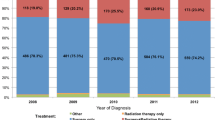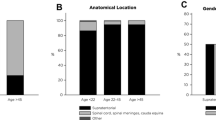Abstract
Introduction
Childhood, adolescent and young adult (CAYA) cancer survivors treated with cranial radiotherapy are at risk for developing subsequent meningiomas. There is insufficient evidence concerning the benefits and harms of screening for subsequent meningiomas, and uncertainty about the most appropriate clinical management of asymptomatic meningiomas. Data describing current clinical decision-making is essential to formulate surveillance recommendations.
Methods
We created an online survey to identify the current international clinical practice regarding screening for and management of subsequent asymptomatic meningiomas among CAYA cancer survivors. Fifty-nine physicians from North America and Europe with expertise relevant to meningiomas were invited to participate.
Results
Thirty-four physicians (58%) completed the survey. The reported number of CAYA cancer survivors that physicians are willing to screen to detect one meningioma varied widely from 0 to 750 (median 50). Physicians expressed concerns regarding harms from MRI screening, including risks of unnecessary interventions (n = 25, 73%) and overdiagnosis (n = 19, 56%). Growth pattern (n = 33, 97%), location (n = 31, 91%) and size (n = 29, 85%) were endorsed as the most important factors influencing the decision to treat asymptomatic meningiomas. A challenging location (n = 14, 52%), indolent tumor growth pattern (n = 13, 48%), and absence of symptoms (n = 12, 44%) were endorsed as the main reasons to monitor without intervention.
Conclusions
There is international variation in opinions and clinical practice regarding screening for subsequent asymptomatic meningiomas among at risk CAYA cancer survivors. Decision-making regarding interventions of asymptomatic meningiomas are largely driven by clinical characteristics. These valuable insights into current clinical practice will inform surveillance guidelines for CAYA cancer survivors.


Similar content being viewed by others
References
Bhatia S, Sklar C (2002) Second cancers in survivors of childhood cancer. Nat Rev Cancer 2:124–132. https://doi.org/10.1038/nrc722
Taylor AJ, Little MP, Winter DL, Sugden E, Ellison DW, Stiller CA, Stovall M, Frobisher C, Lancashire ER, Reulen RC, Hawkins MM (2010) Population-based risks of CNS tumors in survivors of childhood cancer: the British Childhood Cancer Survivor Study. J Clin Oncol 28:5287–5293. https://doi.org/10.1200/JCO.2009.27.0090
Bowers DC, Nathan PC, Constine L, Woodman C, Bhatia S, Keller K, Bashore L (2013) Subsequent neoplasms of the CNS among survivors of childhood cancer: a systematic review. Lancet Oncol 14:e321–e328. https://doi.org/10.1016/s1470-2045(13)70107-4
Bowers DC, Moskowitz CS, Chou JF, Mazewski CM, Neglia JP, Armstrong GT, Leisenring WM, Robison LL, Oeffinger KC (2017) Morbidity and mortality associated with meningioma after cranial radiotherapy: a report from the childhood cancer survivor study. J Clin Oncol 35:1570–1576. https://doi.org/10.1200/JCO.2016.70.1896
Kok JL, Teepen JC, van Leeuwen FE, Tissing WJE, Neggers S, van der Pal HJ, Loonen JJ, Bresters D, Versluys B, van den Heuvel-Eibrink MM, van Dulmen-den Broeder E, van der Heiden-van der Loo M, Aleman BMP, Daniels LA, Haasbeek CJA, Hoeben B, Janssens GO, Maduro JH, Oldenburger F, van Rij C, Tersteeg R, Hauptmann M, Group D-LS, Kremer LCM, Ronckers CM (2019) Risk of benign meningioma after childhood cancer in the DCOG-LATER cohort: contributions of radiation dose, exposed cranial volume, and age. Neuro Oncol 21:392–403. https://doi.org/10.1093/neuonc/noy124
van Alkemade H, de Leau M, Dieleman EM, Kardaun JW, van Os R, Vandertop WP, van Furth WR, Stalpers LJ (2012) Impaired survival and long-term neurological problems in benign meningioma. Neuro Oncol 14:658–666. https://doi.org/10.1093/neuonc/nos013
Sabin ND, Santucci AK, Klimo P, Hudson MM, Srivastava D, Zhang N, Kun LE, Krasin MJ, Pui C-H, Patay Z, Reddick WE, Ogg RJ, Hillenbrand CM, Robison LL, Krull KR, Armstrong GT (2014) Incidental detection of late subsequent intracranial neoplasms with magnetic resonance imaging among adult survivors of childhood cancer. J Cancer Surviv 8:329–335. https://doi.org/10.1007/s11764-014-0344-8
Stevens SP, Main C, Bailey S, Pizer B, English M, Phillips B, Peet A, Avula S, Wilne S, Wheatley K, Kearns PR, Wilson JS (2019) The utility of routine surveillance screening with magnetic resonance imaging to detect tumor recurrence/progression in children with high-grade central nervous system tumors: a systematic review. Pediatr Blood Cancer 66:e27509. https://doi.org/10.1002/pbc.27509
Children's Oncology Group. (2018) Long-term follow-up guidelines for survivors of childhood, adolescent, and young adult cancers. https://www.survivorshipguidelines.org/. Accessed 11 Oct 2019
Dutch Childhood Oncology Group (2010) Richtlijn follow-up na kinderkanker meer dan 5 jaar na diagnose. https://www.skion.nl/. Accessed 11 Oct 2019
Co JL, Swain M, Murray LJ, Ahmed S, Laperriere NJ, Tsang DS, Yu E, Pintilie M, Weiss J, Hodgson DC (2019) Meningioma screening with MRI in childhood leukemia survivors treated with cranial radiation. Int J Radiat Oncol Biol Phys 104:640–643. https://doi.org/10.1016/j.ijrobp.2019.02.057
Banerjee J, Paakko E, Harila M, Herva R, Tuominen J, Koivula A, Lanning M, Harila-Saari A (2009) Radiation-induced meningiomas: a shadow in the success story of childhood leukemia. Neuro Oncol 11:543–549. https://doi.org/10.1215/15228517-2008-122
Goshen Y, Stark B, Kornreich L, Michowiz S, Feinmesser M, Yaniv I (2007) High incidence of meningioma in cranial irradiated survivors of childhood acute lymphoblastic leukemia. Pediatr Blood Cancer 49:294–297. https://doi.org/10.1002/pbc.21153
Paakko E, Talvensaari K, Pyhtinen J, Lanning M (1994) Late cranial MRI after cranial irradiation in survivors of childhood cancer. Neuroradiology 36:652–655. https://doi.org/10.1007/bf00600433
Carter SM, Barratt A (2017) What is overdiagnosis and why should we take it seriously in cancer screening. Public Health Res Pract. https://doi.org/10.17061/phrp2731722
Esserman LJ, Thompson IM Jr, Reid B (2013) Overdiagnosis and overtreatment in cancer: an opportunity for improvement. JAMA 310:797–798. https://doi.org/10.1001/jama.2013.108415
Heleno B, Thomsen MF, Rodrigues DS, Jorgensen KJ, Brodersen J (2013) Quantification of harms in cancer screening trials: literature review. BMJ 347:f5334. https://doi.org/10.1136/bmj.f5334
Io M, Council NR (2003) Fulfilling the potential of cancer prevention and early detection. The National Academies Press, Washington, DC
Islim AI, Mohan M, Moon RDC, Srikandarajah N, Mills SJ, Brodbelt AR, Jenkinson MD (2019) Incidental intracranial meningiomas: a systematic review and meta-analysis of prognostic factors and outcomes. J Neurooncol 142:211–221. https://doi.org/10.1007/s11060-019-03104-3
Comprehensive Cancer Centre the Netherlands (2015) Intracranieel meningeoom. www.oncoline.nl/meningeoom. Accessed 11 Oct 2019
Goldbrunner R, Minniti G, Preusser M, Jenkinson MD, Sallabanda K, Houdart E, von Deimling A, Stavrinou P, Lefranc F, Lund-Johansen M, Moyal EC-J, Brandsma D, Henriksson R, Soffietti R, Weller M (2016) EANO guidelines for the diagnosis and treatment of meningiomas. Lancet Oncol 17:e383–e391. https://doi.org/10.1016/s1470-2045(16)30321-7
Malm HM (1999) Medical screening and the value of early detection. When unwarranted faith leads to unethical recommendations. Hastings Cent Rep 29:26–37
Burger IM, Kass NE (2009) Screening in the dark: ethical considerations of providing screening tests to individuals when evidence is insufficient to support screening populations. Am J Bioeth 9:3–14. https://doi.org/10.1080/15265160902790583
McMillan SS, King M, Tully MP (2016) How to use the nominal group and Delphi techniques. Int J Clin Pharm 38:655–662. https://doi.org/10.1007/s11096-016-0257-x
Van de AH, Delbecq AL (1974) The effectiveness of nominal, delphi, and interacting group decision making processes. Acad Manag J 17:605–621. https://doi.org/10.2307/255641
Black WC, Welch HG (1993) Advances in diagnostic imaging and overestimations of disease prevalence and the benefits of therapy. N Engl J Med 328:1237–1243. https://doi.org/10.1056/NEJM199304293281706
Sindou M (2001) Meningiomas invading the sagittal or transverse sinuses, resection with venous reconstruction. J Clin Neurosci 8(Suppl 1):8–11. https://doi.org/10.1054/jocn.2001.0868
Alexiou GA, Gogou P, Markoula S, Kyritsis AP (2010) Management of meningiomas. Clin Neurol Neurosurg 112:177–182. https://doi.org/10.1016/j.clineuro.2009.12.011
Rubinstein AB, Shalit MN, Cohen ML, Zandbank U, Reichenthal E (1984) Radiation-induced cerebral meningioma: a recognizable entity. J Neurosurg 61:966–971. https://doi.org/10.3171/jns.1984.61.5.0966
van der Vossen S, Schepers VP, Berkelbach van der Sprenkel JW, Visser-Meily JM, Post MW (2014) Cognitive and emotional problems in patients after cerebral meningioma surgery. J Rehabil Med 46:430–437. https://doi.org/10.2340/16501977-1795
Mathiesen T, Kihlström L, Karlsson B, Lindquist C (2003) Potential complications following radiotherapy for meningiomas. Surg Neurol 60:193–198. https://doi.org/10.1016/s0090-3019(03)00377-x
Goebel S, Mehdorn HM (2013) Development of anxiety and depression in patients with benign intracranial meningiomas: a prospective long-term study. Support Care Cancer 21:1365–1372. https://doi.org/10.1007/s00520-012-1675-5
Moore A (2004) How I manage supratentorial meningiomas. ACNR, Wiltshire
Morgenstern PF, Shah K, Dunkel IJ, Reiner AS, Khakoo Y, Rosenblum MK, Gutin P (2016) Meningioma after radiotherapy for malignancy. J Clin Neurosci 30:93–97. https://doi.org/10.1016/j.jocn.2016.02.002
Shah AH, Jusue-Torres I, Kuchakulla M, Ivan ME, Benveniste RJ, Morcos JJ, Komotar RJ (2018) Radiation-induced meningiomas: a case-control study at single center institution. J Neurol Sci 387:205–209. https://doi.org/10.1016/j.jns.2018.02.033
Yamanaka R, Hayano A, Kanayama T (2017) Radiation-induced meningiomas: an exhaustive review of the literature. World Neurosurg 97(635–644):e638. https://doi.org/10.1016/j.wneu.2016.09.094
Acknowledgements
We gratefully acknowledge the kind participation of colleagues who anonymously contributed insight and professional opinion/experience relevant for cancer survivors at risk for subsequent meningioma. The information in this manuscript was previously presented as a poster at the North American Symposium on Late Complications after Childhood Cancer in Atlanta, Georgia in June 2019.
Funding
This work was funded by the Children Cancer Free Foundation (KiKa, Grant No. 246 title: Radiotherapy-related meningiomas, cerebrovascular events, and cataract in childhood cancer survivors: a DCOG-LATER project). Dr. Ronckers was supported by the Dutch Cancer Society (Jr Group Leader Funding, Grant No. 2012-5517).
Author information
Authors and Affiliations
Contributions
All authors contributed to the development of the survey. The survey was conducted by LV and RM. Analysis of the data was performed by LV, RM and LK. All authors contributed to interpretation of the data and commented on previous versions of the manuscript. All authors read and approved the final manuscript.
Corresponding author
Ethics declarations
Conflict of interest
The authors have no conflicts of interest to disclose.
Additional information
Publisher's Note
Springer Nature remains neutral with regard to jurisdictional claims in published maps and institutional affiliations.
Electronic supplementary material
Below is the link to the electronic supplementary material.
Rights and permissions
About this article
Cite this article
Verbruggen, L.C., Hudson, M.M., Bowers, D.C. et al. Variations in screening and management practices for subsequent asymptomatic meningiomas in childhood, adolescent and young adult cancer survivors. J Neurooncol 147, 417–425 (2020). https://doi.org/10.1007/s11060-020-03436-5
Received:
Accepted:
Published:
Issue Date:
DOI: https://doi.org/10.1007/s11060-020-03436-5




